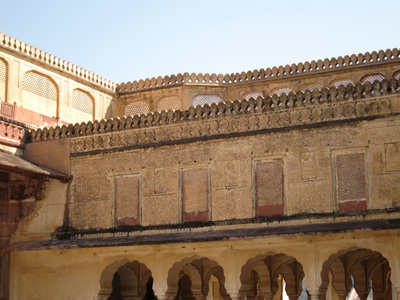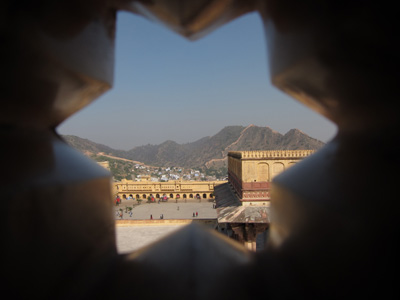 (Our big breakfast at the Taj Mahal Hotel in New Delhi, just before the road trip to Jaipur)
(Our big breakfast at the Taj Mahal Hotel in New Delhi, just before the road trip to Jaipur)
So we had been warned. That the road journey in India was definitely not a walk in the park. Well prepared with a huge breakfast plus snacks and drinks on board, we left Delhi at the crack of dawn the next day to avoid the deadly traffic. The distance ahead of us was just 260 kilometers, but in Indian term, it meant about 6 hours of bumpy, stop-and-go drive on the narrow highway jammed with everything from walking cows to working donkeys, mules, camels, lots of other trucks and buses and people everywhere. Our guide, Khun Yod, told us that we were quite lucky to reach Jaipur in “only” 6 hours. Once, he said, his tour was stuck for hours in this very highway thanks to one cow who decided to take a little siesta in the middle of the road. Apparently a sacred animal in this country, cows were usually left undisturbed no matter how bad chaos they could cause to people’s businesses. And a sleeping cow in the middle of the road was solved only by the patient wait of the people in their vehicles. No one just got the nerve to disturb her away.
 (A traffic scene on the highway from Delhi – Jaipur. We were just entering a toll way)
(A traffic scene on the highway from Delhi – Jaipur. We were just entering a toll way)
Jaipur was a former capital of the glorious Rajasthan state – the largest state of India partly in the Thar Desert, hence extreme weathers during winter and sandstorms in summer. This city was called “Pink City” not because it was naturally made of pink stones, but because its inner walled city was painted pink to welcome the visit of Prince of Wales back in 1853. That part of town remained as pink as it was, hence the name which effectively attracted tourists from around the world.
 (A Jeep waiting for passengers at the foot of Amer Fort)
(A Jeep waiting for passengers at the foot of Amer Fort)
As we were reaching Jaipur, instead of going directly into the city center, we made a stop at the beautiful and grand Amer Fort, a former royal palace of the Rajastani Kings of India. Perched right on a mountain ridge, the Palace’s stretching walls somehow resembled it to the Great Wall of China. To go up there, we needed to get off our bus and chose between the elephant and Jeep taxis. Of course, one with a sensible mind would opt for a Jeep that made a speedy climb up the narrow winding alley to the entrance of the fort at no time.
 (On our way up to the Amer Fort, from the back of a Jeep)
(On our way up to the Amer Fort, from the back of a Jeep)
The Amer Fort, glowing in the afternoon sun, was huge and gorgeous and it was typically divided into sections like any other old palaces of the Moghul Kings. For a history buff, the best thing to do was to hire a tour guide who could then tell you the whole story of each section, including the secretive inner section dedicated only to the royal ladies and their kids. There, in the innermost section, was a steel-cased holy basil plant which Indians believed to be truly holy thanks to millions of health problems it could cure.
 (A section of the gorgeous Amer Fort)
(A section of the gorgeous Amer Fort)
And about two hours later, we were back in the bus, ready to go into the city where we checked in to our gorgeous Jai Mahal Palace – a beautiful and cozy former palace turned into a hotel. Jaipur was a place for one could just stay in a former palace, and one of the most exclusive was the famous Rambagh Palace where we also went for a quick tour.
 (A sneak-peak in the Rambagh Palace Hotel’s main dining room)
(A sneak-peak in the Rambagh Palace Hotel’s main dining room)
But one needed to be happy where one was. And we were quite content with the Jai Mahal Hotel whose lovely large front lawn housed lots and lots of wild birds notably wild parrots, pigeons, orioles and partridges. And this was absolutely lovely.
 (Our lovely room at the Jai Mahal Hotel)
(Our lovely room at the Jai Mahal Hotel)
After a lovely lunch at the hotel, we went downtown into the walled city of which the main street housed the famous Hawa Mahal whose famous façade boasted intricate windows that made Jaipur so mystique. A former residence of the royal ladies, the Palace of Winds was a building of one purpose. It was a house for those ladies with those small windows literally their windows to the world because they were not allowed outside and looking through those peepholes just saved them from the fatal daily boredom.
 (An intricate peephole at the Amer Fort, also used by royal ladies to observe outside daily life back in those days)
(An intricate peephole at the Amer Fort, also used by royal ladies to observe outside daily life back in those days)
Near the Hawa Mahal was the City Palace of the current Maharaja of Rajasthan. The royal residence was private, but tourists could enjoy seeing their extravagant lives through the museums (closed at 5pm) of Rajasthani clans and their fabrics (meaning the stories of their costumes and all). Or one could brave out to the shopping street in front to enjoy the bargain sprees with Indian shop owners for a stacks of shoes, scarfs and some trinkets.
 (Jaipur’s walled city – always a chaos)
(Jaipur’s walled city – always a chaos)
Our day in Jaipur ended with an outing to Chowki Dhani – a so-called “ethnic village” quite a way away from the city. Just like a typical themed park, Chowki Dhani had performances, dances and a restaurant where one could try a typical Rajastani meal. And that was what we did. I had not so much of an idea of what we ate that night. The dimmed place was not that appetizing, but the food was hot and quite tasty. Here is the picture.
